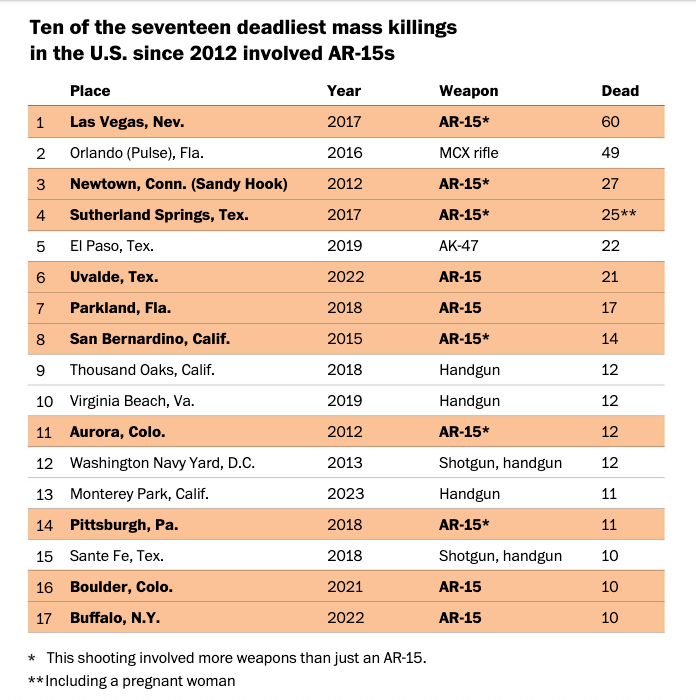The AR-15 is a Weapon of War.
And our domestic battlefield is strewn with the bodies of little children. Some parents, and the Washington Post, decide it is time to show the carnage.

This week the Washington Post has done something exceptional, controversial, and strongly in the public interest.
It showed exactly how human bodies, including the torsos and heads of little children, are blown apart by bullets from AR-15 rifles. That is in the Post’s online graphic feature, here, which went up two days ago. It includes detailed animations of the series of wounds that killed two students, six-year-old Noah Pozner in Newtown CT, and 15-year-old Peter Wang in Parkland FL. These careful recreations, based on autopsy and forensic reports, were shown with the families’ permission.
The print version of this feature occupies most of the newspaper’s front page today, along with several other stories about the AR-15.
There has long been debate about whether to show the results of the gun slaughter that uniquely plagues the United States.
—Is this exploitative, cruel, a form of violence-porn?
—Or is it a necessary reminder of what is happening, the realities of America’s unique tolerance of weapons of war?
The Post decided on the latter. They are right. They, and the families they worked with, have taken an important step.
Soon after the story was published, I got this message from a long-time reader who is a lawyer in a very conservative part of the country:
The horrors of gun violence will not be stopped until the media allows Americans to be horrified….
Children will continue to die by AR-15s in school shootings until Americans are brought to tears and haunted as they try to sleep by bloody images from the slaughters of our society's most innocent….
Showing the carnage is necessary to stop the carnage….
I hope you will favorably compare the brave families of Noah Pozner and Peter Wang with the courage of Mamie Till.
Mamie Till was of course the grieving mother who decided in 1955 that the world needed to see the mutilated body of her 14-year-old son, Emmett, after he had been captured, tortured, and lynched in Mississippi.
Here is a screen-capture image from the Post’s online presentation. It is part of a 3D explanatory rendering of how AR-15 bullets “tumble” when they enter flesh, and thus produce huge scooped-out gouge-type wounds, rather than passing straight through like some other bullets. In this image the AR-15 wound path is in orange; that of a 9mm handgun bullet, in blue.
The animated online version makes the gouging process much more vivid. It shows, for instance, how it looks when a tumbling bullet passes through a child’s heart, or head. If you look at these you will find them hard to forget. Which is the point.
I extend my admiration to the Post’s team of N. Kirkpatrick, Atthar Mirza, and Manuel Canales for their work on this illustrated story; to the Post’s editor, Sally Buzbee, for her explanation of why the paper is showing rather than tactfully concealing the carnage; to the families that have selflessly given permission to produce these images; and to Todd C. Frankel, Shawn Boburg, Josh Dawsey, Ashley Parker, and Alex Horton of the Post for their accompanying story on how the AR-15 became America’s dominant weapon.1 Helping people face reality is one of the things journalism is for.
A breakthrough in killing power, meant for the battlefield, and now brought to our schools.
In addition to drawing further attention to the WaPo features, I am writing this post to emphasize why the AR-15 matters, and to provide more background on why this weapon has such killing power.
1) Why the AR-15 matters.
The AR-15 matters because more of them are in U.S. civilian hands than any other rifle. No one knows the exact number. But within this country, estimates of the AR-15 total start at around 20 million. In the rest of the world they are rare except among government forces, criminal gangs, or some regulated hobbyist or security groups.
The AR-15 matters because it has been used in the majority of recent U.S. mass shootings—which are most of the world’s mass shootings. Here is an illustration from the recent WaPo coverage:
The AR-15 matters because it frightens law enforcement agents. The police in Uvalde did not attack the school murderer because they were “afraid” of his AR-15.
The AR-15 matters because of the particular damage it is able to inflict, as the Washington Post feature illustrates and as I’ll describe below.
2) Where did all the AR-15s come from?
The main timeline of this weapon is:
In the 1950s, it was invented by a renowned engineer and designer named Eugene Stoner, who was working for the Armalite corporation. I wrote about him and his creations in a long Atlantic story more than 40 years ago and in my book National Defense.
In the early 1960s the U.S. military took Stoner’s AR-15 design as the working basis for a new infantry rifle, which after its military modifications would be known as the M16. (Details of the modifications are in my story.) The M16 was in common U.S. military use by the time of the Vietnam war and thereafter.
In the 1960s, there was huge controversy about those military modifications, some of which had made the M16 less reliable and deadly than Stoner’s original AR-15 design. The “Ichord Report,” from a special Congressional investigative committee led by Rep. Richard Ichord, looked into why the M16 had failed in combat. It heard about U.S. soldiers who had died in Vietnam holding jammed M16s in their arms.
Through the 1970s until the early 2000s, the AR-15 was on the civilian market but not a high-volume item. (The M16, like most military equipment, is not available to civilians.) In an Atlantic story last year, a former gun-industry official named Ryan Busse said that in those days, even within the industry “assault rifles and tactical gear were [seen as] a creepy, fringe interest that had no place in a complex democratic society.”
In 2004, a Republican-controlled White House and Congress let a Clinton-era “assault weapon ban” lapse. Through that decade, AR-15 sales rapidly increased, and so did AR-15 massacres.
Eugene Stoner was not around to see what had become of his weapon. He had died in 1997. But as the massacre rate increased, his family came forward to tell NBC News that Stoner himself never thought this rifle should be in civilian hands: “Our father, Eugene Stoner, designed the AR-15 and subsequent M-16 as a military weapon to give our soldiers an advantage," the family said in 2016. “He died long before any mass shootings occurred. But, we do think he would have been horrified and sickened as anyone, if not more by these events.”2
By the early 2020s, AR-15s had become cult and tribal objects, in addition to deadly weapons. Early this year, two first-year Republican congressmen (one of them George Santos) wore AR-15 lapel pins in the Capitol. For his Christmas greeting in 2021, Rep. Thomas Massie sent out this image, part of a trend for other family-with-guns photos from public figures. Those I’ve seen from politicians have all been from Republicans.

3) Why the AR-15 is so deadly.
Also in the 1960s, the military research arm known as DARPA, for Defense Advanced Research Projects Agency, was enthusiastic about the potential of the AR-15 as a replacement for World War II-era rifles. One of its reports compared it with a preceding standard military rifle, the M14, and concluded (emphasis added):
Taking into account the greater lethality of the AR-15 rifle and improvements in accuracy and rate of fire… in overall squad kill potential the AR-15 rifle is up to 5 times as effective as the M-14 rifle. …
The military saw several advantages in the AR-15, including lighter weight, less recoil, and higher reliability. But the change that now matters most, in civilian massacres, was its ammunition:
By using lighter bullets, the AR-15 was able to do far more damage to whatever its bullets hit.
Why? Again I highly recommend the Washington Post online feature. But here is the way I wrote about it in describing how the AR-15 was turned into the M16. The starting point was a 19th-century discovery in the gruesome science of “wound ballistics”:
Here is the story from that 1981 article, and my related book National Defense. Again emphasis added:
The wound ballistics discovery was that a small, fast-traveling bullet often did a great deal more damage than a larger round when fired into human or (for the experiments) animal flesh. A large artillery round might pass straight through a human body, but a small bullet could act like a gouge.
[In the hearings into M16 failures] Rep. Ichord asked Eugene Stoner, the designer of the original version of the M16, to explain the apparent paradox of a small bullet’s destructive power. The answer emerged in the following grisly exchange.
“Ichord: One army boy told me that he had shot a Vietcong near the eye with an M14 [which uses a heavier bullet] and the bullet did not make too large a hole on exit, but he shot a Vietcong under similar circumstances in the same place with an M16 and his whole head was reduced to pulp. This would not appear to make sense. You have greater velocity but the bullet is lighter.”
“Stoner: There is the advantage that a small or light bullet has over a heavy one when it comes to wound ballistics. … What it amounts to is the fact that bullets are stabilized to fly through the air, and not through water, or a body, which is approximately the same density as the water. And they are stable as long as they are in the air. When they hit something, they immediately go unstable. … If you are talking about .30-caliber [in the M14], this might remain stable through a human body. … While a little bullet, being it has a low mass, it senses an instability situation faster and reacts much faster. … this is what makes a little bullet pay off so much in wound ballistics.”
The “payoff” in wound ballistics, the increase in overall “kill potential”—these are what the cults of the AR-15 have brought us, and what the Washington Post and these brave parents should help us see.
The AR-15 was originally made by the Armalite company, which is the source of the “AR” in its name. Now it describes a type of weapon produced by many companies. Also a style note: the AR-15 is usually written with a hyphen. Although usage varies, the U.S. military usually omits the hyphen. Thus I am writing “AR-15” for the civilian-market model, and “M16” for the military’s version.
Another armaments engineer wrote to me with similar views several years ago, as noted here.






JIm yes the Post is to be saluted for its AR-15 project but, as those demented photos acompanying your piece make chillingly clear, this is a sick, sick country we live in and I doubt any journalistic effort, no matter how well done, can even begin to cure what ails us. The statistics tell the tale. More than 400 million gun owners in this country . . . . 20 million AR-15 style weapons in private hands . . . 500 companies manufacturing AR-15 style guns and accessories . . . As a Poynter Institute report put it last year, the AR-15 has become "the poster child" of right-wing advocacy of gun ownership. By now it has become only too clear that no matter how many children are slaughtered by wackos using this or other firearms, no matter how wrenching the stories their bereaved parents have to tell, no matter how upset the rest of us may be, it is too late to stuff this genie back into the bottle. Of course journalists should continue to keep this issue on the front burner and of course those who feel strongly about it should continue to push for change. But . . . profoundly depressing, this. At 85, I wish I could see a way out but I can't. Can you? Can anyone?
I've read other accounts of the destructive capacity for this particular weapon - as I recall, one was from a surgeon who had struggled to repair such damage. Unfortunately, these arguments are lost in the overall psychosis among a large portion of the American electorate that caused British columnist Dan Hodges to observe in his tragic tweet from 2015:
"In retrospect Sandy Hook marked the end of the US gun control debate. Once America decided killing children was bearable, it was over."
I distinctly recall the vote in the Senate not long after the Sandy Hook massacre, when senators openly and unabashedly caved to their NRA overlords, and then offered one pathetic, disingenuous excuse after another for their vote. Even the most watered down attempts to prevent the sale of guns to those who were likely to use them in mass shootings was voted down, mostly because the NRA wants absolutely no restrictions whatsoever on the sale of guns. The reason is quite simple: more guns = more profits for the gun manufacturers who fund the organization.
But the biggest problem is people like the congressman and his family shown in the photo: the "Charlton Heston crowd" that equates gun ownership with strength, courage, righteousness, and all that they believe is good about America. With this attitude, any and all attempts to restrict ownership and use of any gun at any time are viewed as attacks against the bedrock principles of American freedom, strength, and independence. It's like a yes vote to lock up Superman in a cell filled with kryptonite - how could anyone possibly be in favor of destroying "truth, justice and the American way"?
The greatest fear of gun safety legislation from the right is not that it won't work, but that it will. Because when such legislation does pass, and when gun deaths are reduced as a result, it might just put a crack in that façade of righteousness that has sustained the pro-gun movement thus far. And that is why it is so essential that we continue to work hard to support such common sense measures, and to hold our elected officials accountable when they refuse to support our efforts.